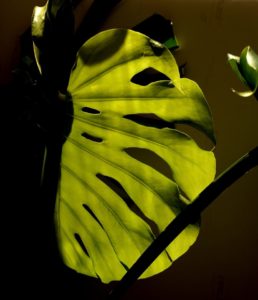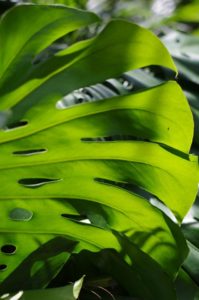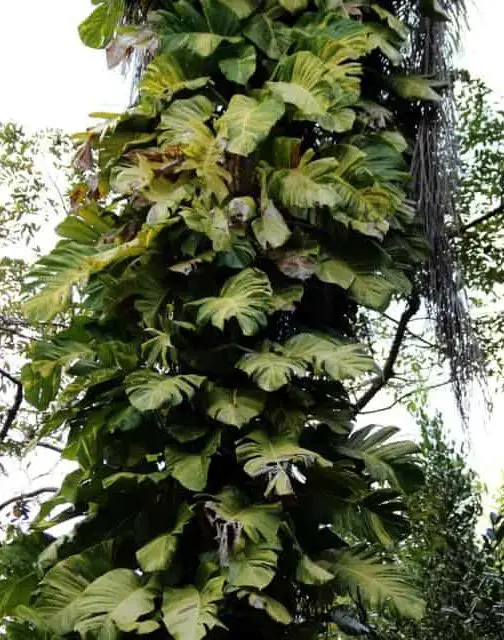Some links in the post are affiliate links and I get a commission from purchases made through some links found in the post.
You may also know the Monstera as the Cheese plant, Mexican breadfruit, or the Split Leaf Philodendron.
Whichever name you recognise, the Monstera Deliciosa is one of the most well-known and easily recognisable plants in the world. They are known mostly as houseplants although they can grow outside if conditions are right.
In its native state the Monstera does indeed grow naturally outside. They originate from Central American rainforests where the temperatures are between 68 – 86 degrees F, making them ideal plants for hot regions.
An interesting fact about the ‘holes’ in the leaves is that in the natural habitat increase the spread of the leaves while at the same time decreasing the leaf cells it needs to support.
The fenestrations, as they are called, are there to capture the maximum amount of sun on the forest floor around the plant.
Monstera plants can grow well outdoors in USDA hardiness zones 10 to 12. It can be a lot harder to grow them outside of these zones but with the right care and protection you can grow them outside.
To grow a monstera outside you need well draining soil and to give it bright indirect light. The ideal temperatures are between 68-86 degrees F and you will need to protect them from pests.
Are Monstera Indoor or Outdoor Plants?
Although we often think of Monsteras as indoor houseplants, they do in fact survive very well outdoors.
If we think about their natural conditions from the tropics, we see that they would do well in partial shade areas, a dappled sunlight position. The temperatures would also be temperate.
However, the Monstera is very adaptable and can do well in most climates apart from very cold indoor places.
Where is Monstera’s Natural Habitat?
 The Monstera is a species of flowering plant which comes from the tropical forests of southern Mexico. You will also find then south right down to Panama, after which it becomes too cold for them to do well.
The Monstera is a species of flowering plant which comes from the tropical forests of southern Mexico. You will also find then south right down to Panama, after which it becomes too cold for them to do well.
Monsteras were introduced to many other tropical areas such as Hawaii and the Seychelles, where they are now considered a mildly invasive species.
In the natural habitat where conditions are perfect the Monstera can easily reach up to 20 metres in height. Indoors, in a container it can reach up to 5 metres in height and about 2-3 metres in width.
Can a Monstera Live Outside all Year Round?
When we talk about keeping a houseplant outside, we invariably think about the winter conditions which may harm the plant.
While these must be taken into consideration, we also need to think about the conditions in summer which can affect the plant as badly as the cold.
Monsteras live very well outdoors in mild climates. Remember that it comes from Mexico and Central America. While it grows naturally in mild temperatures, it simply cannot tolerate frosts and freezing conditions.
Wherever you are in the world, if the temperatures drop below 50 degrees Fahrenheit, you need to bring your Monstera indoors.
Can I put my Monstera Outside in America?
If you take the time to acclimate your monstera correctly, then yes, you can keep it outside. However, you must bring it back indoors at the first sign of frost otherwise it will not survive.
Monsteras can do well in zones 10 and 11 in the USA, and in zones 8 and 9 you may need to wait until April for better weather conditions.
Ideally the best zones in the USA for Monsteras are zones 10 – 12.
Can I put my Monstera Outside in the UK?
Although we tend to think of the UK as being cold most of the year, it is in fact considered to be a temperate climate. Depending on where you live in the country you may very seldom even see snow.
What you will see in most of the country is frost, and sometimes very heavy frost. So, while you can keep your Monstera outdoors in the UK, you will need to bring it back inside at the first report of expected frost.
Before we mention the lowest temperatures that your Monstera will survive in, there are some other factors to think about when leaving the plant outside.
If you’re enjoying this article, check out our article on how to care for a monstera
Things that will Affect your Outside Monstera
Rain
Although Monstera’s are very durable and quite hardy, excess water in the form of rain does not make them happy. Rain in the tropics differs from a constant rain which may be the norm where you live.
Unless you can give the plant some form of protection such as a roof over it, it may not do too well.
Temperatures
Coming from the tropics, Monsteras are used to moderate temperatures and if you want to leave it outside where the daily temperatures are low, then you will not have a happy plant.
Ideally they need to have temperatures between 68-86 degrees F. Much higher, as well as much lower, will both be detrimental for them.
Sunlight
Thinking again of where they come from, we see that in the rainforest they receive dappled sunlight and not full, direct sunlight.
If you plan on keeping your Monstera outside then look for a spot that offers shade rather then sunlight. Odd as it may seem, your Monstera can burn if it is in too much sunlight.
Bugs and Pests
Thrips are the bane of the Monstera’s life. They attack the plant frequently and placing the plant outside simply attracts more of them. Additionally, they easily pass thrips on to plants which are close by.
Consider the Cost
Although they are not particularly expensive to buy, there are some variants that are quite rare. If you happen to own one of these, you may wake up to find that it has been stolen.
Indeed, many Monstera’s that have reached a good size are a great attraction to a thief. Unfortunately, the police are less than willing to follow up on the theft of a plant as there may be no way of ever proving it is yours.
So, can the Monstera live Outside in the Winter?
Officially a Monstera requires temperatures of no less than 64.4 degrees F (18 degrees C) but if the plant is outside and protected from frost it may grow with temperatures of 50 degrees F (10 degrees C).
However, you may find that your Monstera is simply not happy with temperatures that low and just does not do well. You will also notice that the growth is stunted.
In instances like this it seems a better idea to bring your monstera indoors until the temperatures increase.
Will Putting my Monstera Outside Help it Grow?

The advantage of placing your Monstera outside is that it has conditions similar to those of the original habitat. Natural conditions which help the plant to thrive and grow to its full expectancy.
On the other hand, placing it outside may not be the best idea if the plant gets more sunlight than it can handle. In this case, too much sunlight can burn your Monstera and do it more harm than good.
If you can replicate the natural conditions, then your plant will do well outside and if not, best to bring it inside.
If you are enjoying this article, check out our article on why is my monstera drooping.
How to get your Monstera Used to Living Outside
Possibly the most important thing when getting your Monstera used to living outside is to be aware of the sunlight it receives.
Remember that Monsteras prefer shade to sunlight. Direct sunlight can burn and destroy the leaves.
Your plant needs time to adapt to outdoor conditions. If it is in a pot and happens to grow into some sunlight, it will adapt on its own, without being moved to the sun.
Your outdoor Monstera will need to be watered more frequently that an indoor plant, particularly during the dry season.
You will need to keep a close eye for pests, and in particular thrips which will attack your plant with vigour. Treat with Neem Oil often or invest in an insecticide powder to keep them under control.
The Monstera will need watering regularly and will need a monthly dose of fertilizer.
Where to put your Monstera Outside
The best place to put a Monstera outside is in a sheltered spot where you know it will not be touched by frost. Neither should it catch the winter winds which will dry out the soil.
Place your Monstera in a well-drained spot, or even in a raised bed where it receives dappled shade.
Ideally you should construct a sturdy support as this plant will grow up to 2’ every year.
If you are placing your Monstera in the ground you must be able to cover it with a frost blanket or with plastic sheeting to protect it. Placing poles around the plant will enable you to drape the cover over the plant in winter.
Let’s talk about invasiveness
In some areas of the USA the plant is considered to be mildly invasive. This is normally in states where you would be more likely to plant them outside as the climate is more suitable. Florida actually recommends planting your Monstera outside.
So, just like any other plant that finds the perfect living conditions, your Monstera will thrive in good conditions.
Monsteras are known to be very competitive when searching for nutrients and while they may not leach nutrients from other plants, they are known to climb host trees in search of food.
The roots of the Monstera may damage other plants close by which is why you may want to contain them in a barrier below the soil surface.
One thing to be aware of if you plant your Monstera outdoors is that it will go in search of nutrients so if you have things like telephone poles and other trees, you can expect to see your Monstera heading that way.
Additionally, if you neighbour has more nutritional soil on the other side of the hedge then guess where your Monstera’s roots will head?
You may also like: How do you save a damaged monstera
Can I Propagate my Monstera?
The good thing is that you can propagate the plant and it is relatively easy to do so. All you need to do is take a stem cutting.
Make sure to cut the stem at least 3” below any joint in the stem. Now remove all the lower leaves from your cutting and place it in water.
Keep your cutting in the water in medium light and top up when needed. Soon you will see tiny roots appear.
Another way to propagate the Monstera is to place your cutting in a mixture of equal parts sand and compost. An orchid mix will work well also.
Roots and new growth will appear in a few weeks.
If you have planted your new Monsteras in pots then be sure to repot them every 18-24 months to stop them getting pot bound.
Are Monstera’s Toxic?
It is advisable that you keep both pets and children away from these plants. Although they would need to ingest a large amount to be fatal, the calcium oxalate crystals will cause an intense burning in the mouth, on the tongue and in the throat.
Apart from the fruit, if any other part is swallowed you can expect nausea, diarrhoea, and vomiting.
The fruit is edible but if you are unlucky enough to eat it before it is completely ripe it will irritate your mouth and throat. Never eat the fruit if it is unripe.
Further, the sap from the Monstera can cause skin irritation so it is a good idea to wear gloves when trimming the plant.
It is best therefore, to keep your plant away from curious children and any pets you may have.
For more on this, check out our article here.
Final Thoughts
 Generally, Monstera’s do not suffer from too many blights and are apart from thrips, pest-free. Be prepared to treat for thrips often as they do love infesting the Monstera.
Generally, Monstera’s do not suffer from too many blights and are apart from thrips, pest-free. Be prepared to treat for thrips often as they do love infesting the Monstera.
If you can provide good conditions for your Monstera, then it will reward you with magnificent leaves of glossy deep green. Remember, however, that it can grow to a huge plant so make sure that you can accommodate it.
Normally the Monstera will only bloom outside or somewhere that is like its natural habitat. It is rare to see one flower indoors so if you choose to plant yours outdoors you may well see a bloom if the conditions replicate its natural habitat.
The Monstera is classed as relatively low maintenance and with a bit of planning you can have this spectacular specimen grace your home or garden for many years.


